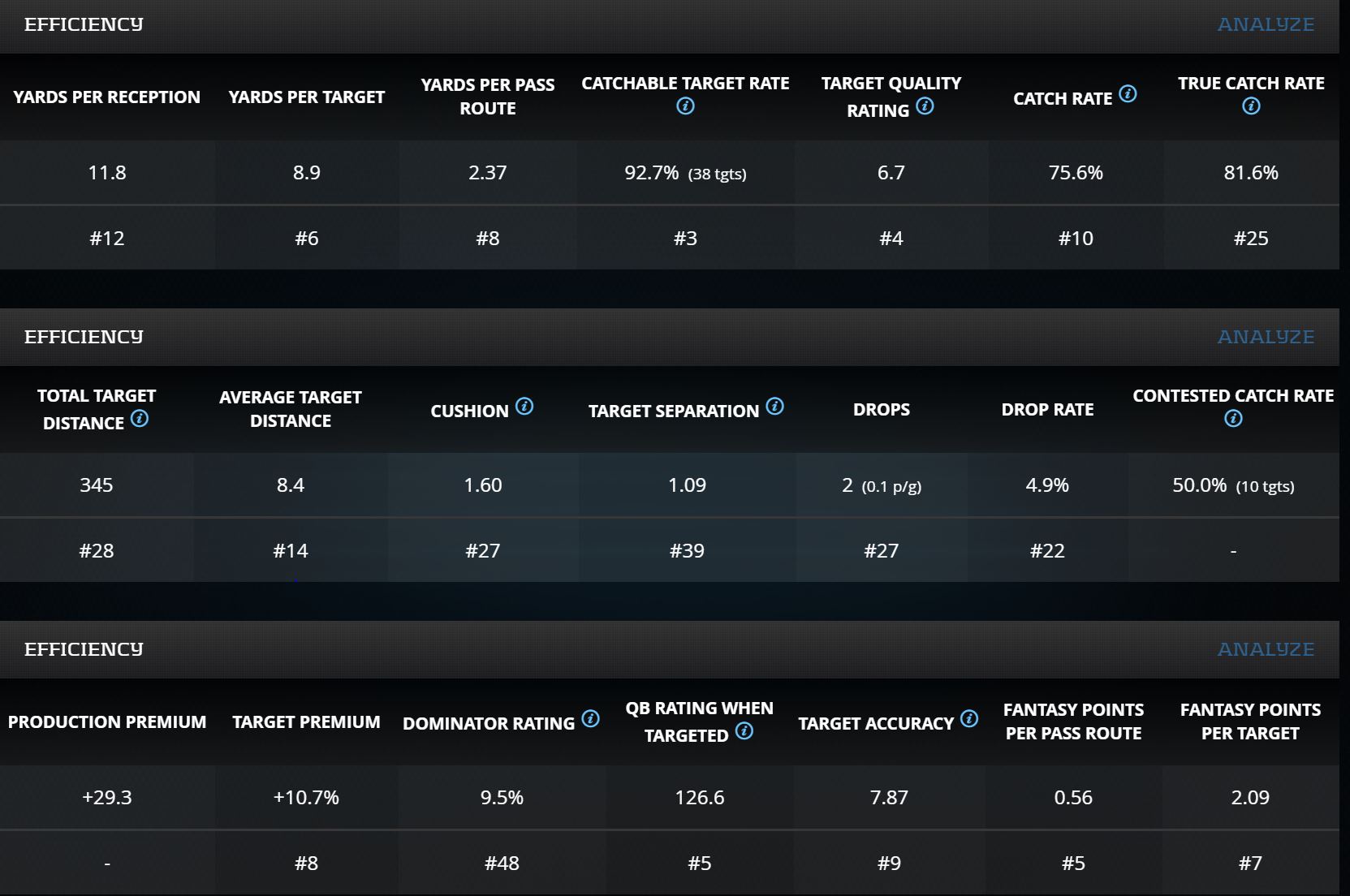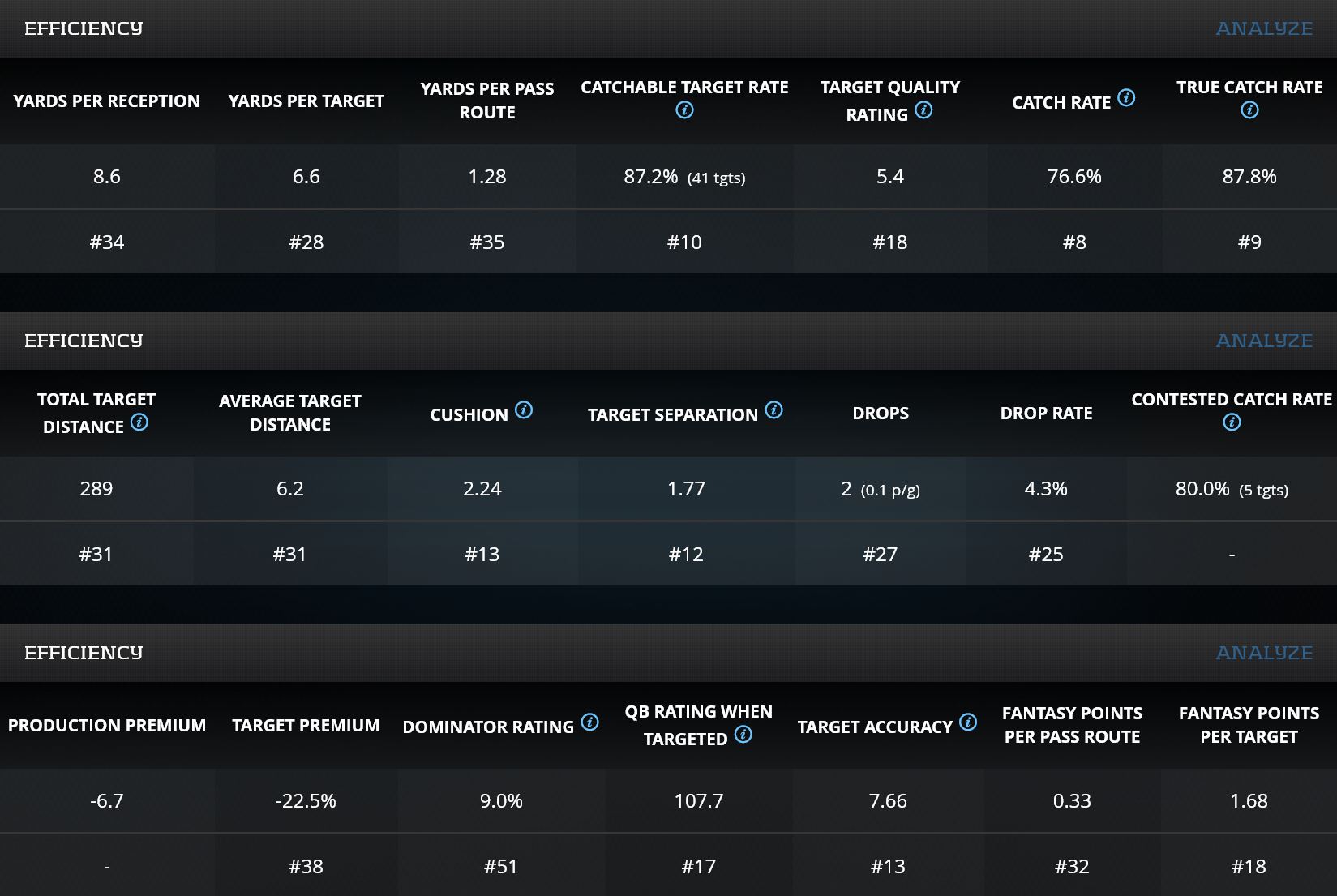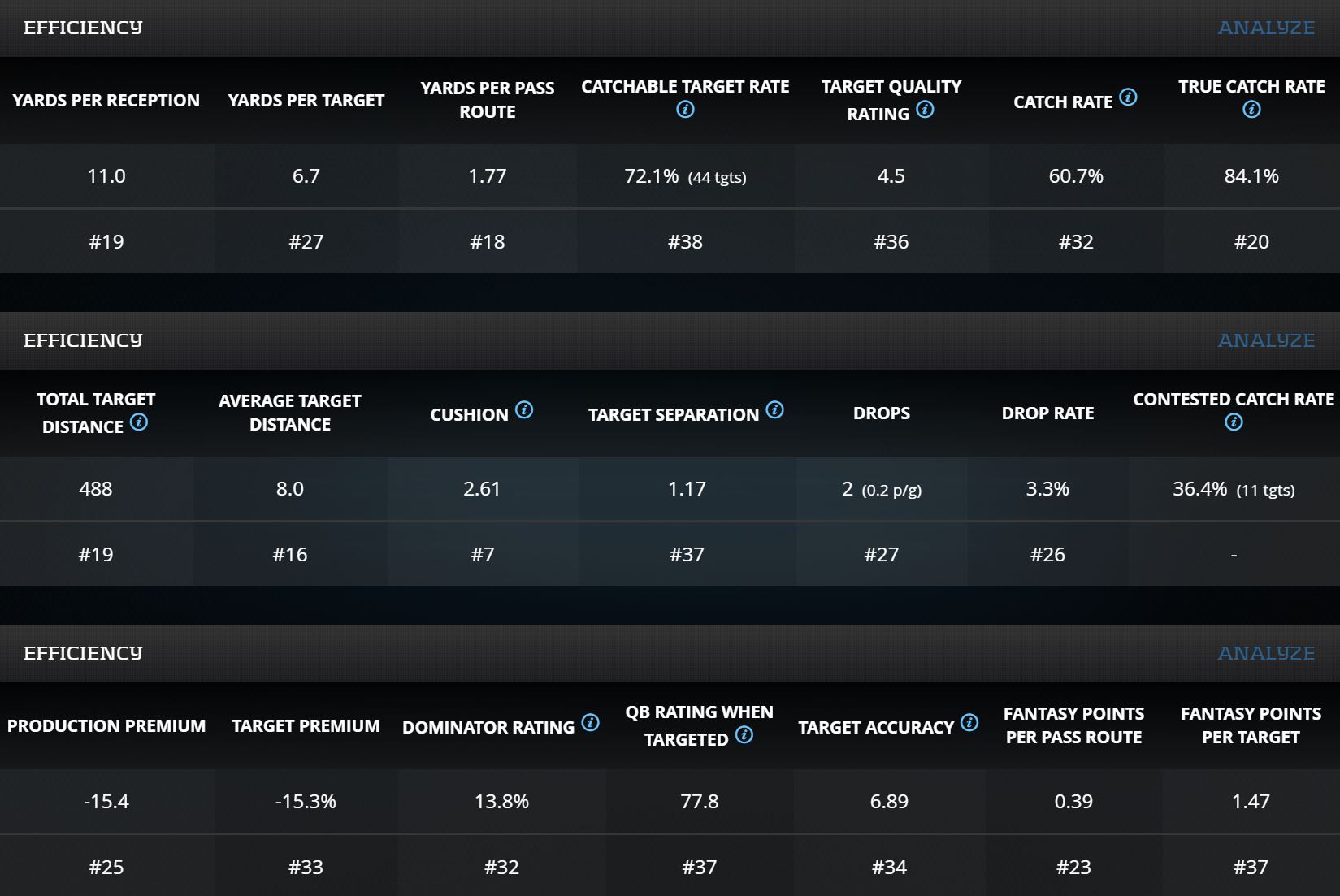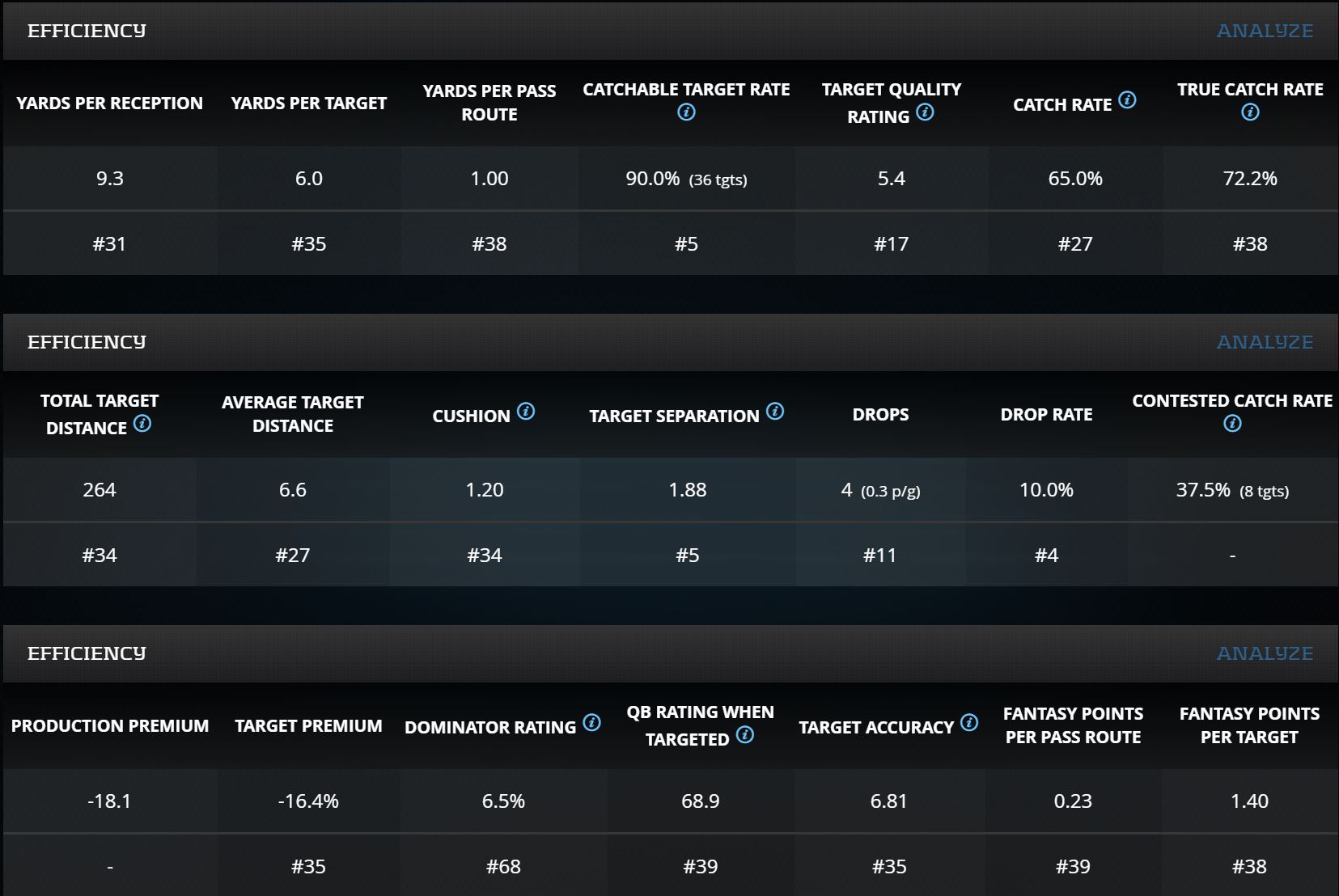From The Podfather firing off warning flares about draft-capital adjusted bust rates and physical fragility rates at the tight end position in 2015, to my recommending players who fit the same stud archetype as Rob Gronkowski and Travis Kelce at a fraction of the cost and risk, we’ve preached a late round tight end strategy in fantasy drafts since PlayerProfiler’s inception. Our advanced stats and metrics pointed fantasy gamers to Tyler Eifert, a league-winning value, in the first year of what’s come to be known as Late Round Tight End Roulette.
The late round tight end strategy is not sexy. There’s a feeling of safety that comes with drafting an elite player at the position. It eliminates the need to scour the waiver wire to play matchups. Given the rise in popularity of leagues with tight end premium scoring and/or multiple flex spots, the allure of picking an elite player at a fragile position is understandable. However, due to the aforementioned fragility rates, tight end output is almost as volatile and difficult to forecast year-to-year as running back output.
https://www.youtube.com/watch?v=k0HN40DXisM
Regardless of draft position, the best-value tight ends in fantasy football over the years have been the 6-5, 250-plus-pounders that see the field on third downs and in the red zone. Also known as the high-leverage fantasy point-scoring situations. Players who fit the league-winning archetype will be available in the final rounds. Mixing and matching one or more, or taking one behind an elite option in the earlier rounds, is the way.
What To Look For
Ideally, our LRTE Roulette candidates would fit all the criteria we look for in evaluating the position. Though, with every player and situation being different, we have to digress where possible. Let’s look at said criteria while examining Mark Andrews, the big winner from last season’s edition.
Size: Andrews checks this box at 6-5, 256-pounds, but being off isn’t a death sentence depending on a player’s role.
Weight-Adjusted Agility: Though we’d prefer our tight ends to have elite weight-adjusted agility, we can look past Andrews having an 11.72 (32nd-percentile among qualified tight ends) Agility Score because of the role he plays in the Baltimore offense and how effectively he plays it.
Opportunity Metrics: Additionally, we like to see Hog Rates at or above 10-percent, along with Snap Shares and Red Zone Target Shares at or near the top of the position. Last year, Andrews led all qualified tight ends with a 23.4-percent Hog Rate, drawing 98 (No. 5) targets despite his 43.2-percent (No. 67) Snap Share. An ideal situation for fantasy purposes, even if unsustainable. What has helped ease the usage concerns is his ranking Top-5 in Slot Rate at the position in each of his first two pro seasons. He also proved to be a red zone force, his 23.4-percent (No. 8) Red Zone Target Share and eight (No. 6) Red Zone Receptions helping him lead the position with 10 (No. 1) touchdowns. Any TE available in the late rounds who is set to inherit their team’s starting role and thus see a massive opportunity spike should be targeted.
Check out Mark Andrews’ 2020 Projection on PlayerProfiler’s “World Famous” Draft Kit:
Productivity Metrics: The most important metric to focus on here is Yards after Catch, of which Andrews logged 250 (No. 9) with 2.6 per target.
Downfield Efficiency Metrics: We also like when our tight ends are utilized downfield, adding importance to efficiency metrics such as Yards per Target, Yards per Reception, and Average Target Distance. Having high Catchable Target and Target Quality Ratings helps as well. Andrews averaged 8.7 (No. 7) Yards per Target and 13.3 (No. 5) Yards per Reception with 11.8 (No. 1) yards of Average Target Distance in 2019. All while drawing 20 (No. 1) Deep Targets. Though his 82.7-percent (No. 19) Catchable Target Rating was middling, his 6.9 (No. 2) Target Quality Rating shows that Lamar Jackson made the catchable throws count.
Other Efficiency Metrics: In addition, pay attention to both Contested Catch Rate and True Catch Rate. Andrews dropping five passes last year affected his 79.0-percent (No. 33) True Catch Rate, but he made up for it with a 35.3-percent (No. 3) Contested Catch Rate on 17 targets. Additionally, we also want a high Target Separation mark. Andrews averaging 1.83 (No. 9) yards of Target Separation helped him succeed both in the red zone and in the deep quadrants of the field.
Late Round Tight End Roulette 2020
There’s no shortage of arguments to be made for Late Round Tight End Roulette candidates in 2020, with many Underworld writers having already made cases for a few. Think of this as something of a glossary of late round options at the position. After going through the metrics and different team situations, it’s been decided that this year’s edition of the series will be split into two parts, both focusing on players with FFPC ADPs past pick No. 100. This part will cover players from the NFC, the next will cover players from the AFC.
So spin that wheel, cut that pack and roll those loaded dice. Bring on the dancing girls, put the champagne on ice and join the Underworld for Part 1 of the sixth annual Late Round Tight End Roulette.
Ian Thomas (FFPC ADP: 122.38)
Overpaying for potential relative to prior fantasy production, or lack thereof, is a dangerous game. Any fantasy gamer who has been burned by enough mid-round “sleepers” can attest to this. After being groomed to take over for Greg Olsen for the last two years, Ian Thomas is set to become Carolina’s starting tight end and nobody seems to care. Though his career efficiency metrics have not been impressive, he has produced TE1 fantasy performances when Olsen has missed time. Unlike our other LRTE Roulette candidates, Thomas has multiple games with a Snap Share above 90-percent on his pro resume, including his lone TE1 outing last year. His Snap Share dropped from 72.0-percent (No. 19) in 2018 to 41.5-percent (No. 71) last year, but his Hog Rate improved from 10.5-percent (No. 20) on 49 (No. 19) targets to 11.7-percent on 31 (No. 40) targets.
https://www.youtube.com/watch?v=29jlPetOeTM
Though 31 targets weren’t enough to qualify Thomas for nearly any of our efficiency metrics, it’s worth noting that his 71.0-percent Catchable Target Rate with the terrible Kyle Allen at quarterback would’ve put him only above Mike Gesicki for worst in the league among qualified players. Likewise, all his most important efficiency metrics were much better in 2018 with Cam Newton primarily under center. Exit Allen and enter the underrated, underappreciated Teddy Bridgewater along with a new, forward-thinking coaching staff. Add a defense that has been decimated over the offseason and has to play in an NFC South division with teams who aren’t shy about scoring points. Now add a newly-minted starting tight end with elite athleticism at 6-4, 259-pounds and an 11.35 (78th-percentile) Agility Score. One whose team has 155 (No. 7) Vacated Targets and draws the second-easiest projected schedule of pass defenses. You know what to do.
Dallas Goedert (FFPC ADP: 100.57)
Philadelphia’s wide receiver core resembled the walking wounded in 2019. It contributed to the team running enough 12-personnel to help Dallas Goedert record a career-high 69.3-percent (No. 22) Snap Share, which he parlayed into a 12.6-percent (No. 17) Hog Rate on 87 (No. 9) targets. Though he finished as a fantasy TE1 on a per-game basis with 9.6 (No. 11) Fantasy Points per Game, he didn’t blow away the field in any particular efficiency metric that we look for. Much of his production was fueled by volume, but he still bested Zach Ertz in nearly all of the most important efficiency metrics. Ertz did record 9.0 (No. 12) yards of Average Target Distance, but at 6.8 (No. 25) Yards per Target, he needed 134 (No. 2) targets to get there.
It’s fitting that Goedert’s Best Comparable Player is Tyler Eifert, the LRTE OG, whose ADP also began creeping towards the single digit rounds before 2015 drafts. At 6-5, 256-pounds, he checks the all-important size box. Athletically, he checks the weight-adjusted agility box, evidenced by a 11.33 (79th-percentile) Agility Score. It’s a better score than that of many running backs and he recorded it at 256-pounds. His 337 (No. 5) Yards After Catch with 3.9 per target is also much more impressive than Ertz managing 250 (No. 9) Yards After Catch with only 1.9 per target.
https://www.youtube.com/watch?v=KzG2Si8AW5o
While a healthier wide receiver core would reduce the need to run as much 12-personnel, Goedert can still have standalone fantasy value and would be a league winner if Ertz, who has a 54.9-percent (No. 7) Injury Probability Rating and 52.3 (No. 14) Fragility Rating, were to go down.
Blake Jarwin (FFPC ADP: 113.35)
Blake Jarwin arrived in Week 17 of the 2018 season, dropping 36.9 fantasy points (7-119-3) on the New York Giants. Though he again played second banana to Jason Witten last year, only seeing a 39.1-percent (No. 78) Snap Share, he did have a 10.7-percent (No. 22) Hog Rate on a mere 41 (No. 34) targets. He only scored three (No. 19) touchdowns, but his 9.7-percent TD Rate best exemplifies how efficient he was. Dak Prescott taking a massive step forward helped. Meanwhile, Witten is gone and Jarwin, who received a three-year extension back in March, inherits the starting tight end job on a team with 190 (No. 2) Vacated Targets. When considering that Dallas can stand to improve on last year’s 38.3 (No. 13) pass plays per game, the case can be made that Jarwin is set for a massive opportunity spike.
At 6-5, 246-pounds with a subpar 11.71 (32nd-percentile) Agility Score, Jarwin is best utilized as a seam-stretcher. Though, interestingly enough, all three of his career red zone receptions have resulted in touchdowns. With Amari Cooper, Michael Gallup and CeeDee Lamb comprising arguably the league’s best wide receiver core, Jarwin’s upside is slightly capped. That’s already baked into his ADP, though the extent of the looming opportunity spike can’t be understated. Efficiency-wise, he’s hit 11.0 Yards per Reception and 8.0 Yards per Target in two consecutive years. Impressively doing so while going from a league-best 2.42 (No. 1) Target Separation mark in 2018 to a league-worst 1.09 (No. 39) mark last year.
https://www.youtube.com/watch?v=20bdzQqvlHg
While Jarwin is set to smash his career bests as it relates to his counting stats, an injury elsewhere would give him triple-digit target potential. I’ll take that league-winning upside in the double-digit rounds.
Irv Smith (FFPC ADP: 136.97)
Despite Minnesota averaging 30.9 (No. 31) pass plays per game, Irv Smith was among the most productive 21-year-old rookie tight ends in league history. The Vikings only running less 12-personnel than Philadelphia last year helped Smith record a 61.7-percent (No. 34) Snap Share. He only managed a 9.1-percent (No. 27) Hog Rate on 47 (No. 30) targets, but he drew a 20.8-percent (No. 12) Red Zone Target Share and logged seven (No. 11) Red Zone Receptions. This despite his “move” tight end stature at 6-2, 242-pounds and 11.65 (40th-percentile) Agility Score. Averaging 1.77 (No. 12) yards of Target Separation and having a 31.5-percent (No. 10) Slot Rate helped with that. If he can come close to those marks next year and maintain his red zone usage, he should score more than two (No. 33) touchdowns.
Smith’s efficiency metrics, while not particularly noteworthy, were impressive for such a young rookie. While the efficiency has room to improve, so does the pass volume in Minnesota. We know the Vikings want to establish the run, but though they draw the fifth-easiest projected schedule of rush defenses, much still has to go right in order for them to remain as run-heavy as they’d like to be. Especially given all the defensive departures. If the bottom were to fall out defensively, it’s important to note that the team also draws the seventh-easiest projected schedule of pass defenses.
https://www.youtube.com/watch?v=uu1SgRb5PMw
Justin Jefferson may have been drafted in the first round to help replace Stefon Diggs, but because the team literally has nothing else at receiver and Kyle Rudolph is slowly being phased out, Smith is in a tremendous position to become the passing game’s No. 2 option from the start of the season.
Gerald Everett (FFPC ADP: 169.37)
Gerald Everett being selected nearly 100 spots after teammate Tyler Higbee in FFPC drafts makes zero sense. In a breakout season derailed by a Week 12 knee hyperextension, Everett turned his 56.2-percent (No. 40) Snap Share into a 14.5-percent (No. 9) Hog Rate on 61 (No. 19) targets. At 6-3, 239-pounds, he’s a “move” tight end with elite athleticism and an 11.32 (82nd-percentile) Agility Score. It’s why he was used both as a deep threat, with eight (No. 9) Deep Targets, and as a red zone weapon, with an 18.2-percent (No. 18) Red Zone Target Share and seven (No. 11) Red Zone Receptions. Adding 178 (No. 18) Yards after Catch was nice, only scoring two (No. 33) touchdowns was not.
Preferably, a player with Everett’s athleticism profile would record stronger efficiency metrics. Although enough improvement from Jared Goff to bump up the Catchable Target Rate and Target Quality Rating, which would also help out out with the Target Separation, would go a long way towards improving those numbers in 2020. Though Higbee’s efficiency metrics were superior for the most part, his splits with and without Everett on the field last year are well-documented.
https://www.youtube.com/watch?v=6t86k3e6PeI
Without Everett being injured, Higbee wouldn’t have put up 31-percent of his career yardage in a five-week span with top-tier matchups. That Everett managed to record a 50.2-percent (No. 28) Route Participation mark in 12 games played compared to Higbee’s 45.4-percent (No. 33) mark in 14 games played tells us all we need to know about who the better player is when both are healthy. In short, an offense that averaged a league third-best 2.38 plays per minute facing 2020’s most difficult projected run game schedule will produce enough passing volume to potentially make Everett a league-winning value pick.
Deep Cuts
With his rookie season basically being an injury redshirt year, Jace Sternberger is a complete unknown with tantalizing upside. His college profile is elite, with a 32.7-percent (92nd-percentile) College Dominator Rating and 17.3 (94th-percentile) College YPR. At 6-4, 251-pounds with an 11.50 (63rd-percentile) Agility Score, it’s easy to see how he led Texas A&M in every major receiving category in his final season. He’s now the starting tight end on a Packers team with 132 (No. 8) Vacated Targets and an uncertain Target Share distribution behind Davante Adams. In other words, it’s Wheels Up.
https://www.youtube.com/watch?v=jpzmjr4LWjM
Greg Olsen has some upside alongside Russell Wilson in Seattle, but there are better bets than a 35-year old who’s changing teams and owns PlayerProfiler’s top Injury Probability Rating and top Fragility Rating. Especially with the hyper-efficient, but hyper-fragile, Will Dissly to contend with. Furthermore, Jacob Hollister and his 22.6-percent (No. 10) Red Zone Target Share from 2019 are still around, making this a situation to avoid.
Jimmy Graham is also an older, declining player who is changing teams and who we can safely pass on.
O.J. Howard‘s role didn’t change last year, he was just extremely inefficient. He averaged 13.5 (No. 4) Yards per Reception and 8.5 (No. 10) Yards per Target, drawing 12 (No. 4) Deep Targets. However, even though his Snap Share jumped from 63.4-percent (No. 28) in 2018 to 79.6-percent (No. 11) last year, his Hog Rate plummeted from 11.5-percent (No. 14) to 7.6-percent (No. 32). Look to his 11.1-percent (No. 2) Drop Rate for the reason. Additionally, he’s never been a factor in the red zone and is now strictly an injury handcuff to Rob Gronkowski. Though with Gronk owning our No. 2 Injury Probability and Fragility Ratings, Howard should be on your waiver wire speed dial.
Deeper Cuts
These players, while also great waver wire speed dial candidates in regular leagues, should be drafted in formats with Scott Fish Bowl-level deep rosters.
The most inexpensive projected starting tight end is Washington’s Jeremy Sprinkle. He has the size at 6-5, 252-pounds, and his 11.63 (43rd-percentile) Agility Score isn’t bad given his size. I just wish he gave us something after spending most of last season as Washington’s starter. His opportunity and production metrics underwhelmed despite a 67.6-percent (No. 25) Snap Share. His efficiency metrics underwhelmed despite Top-5 Catchable Target Rate and Target Separation marks and a good Target Quality Rating. What he does have going for him is the starting role and team/offensive continuity in a year where continuity will be pivotal. Plus, how can you not root for him to succeed when he has such an awesome name?
The Cameron Brate fairy tale is over. Don’t fall for it when he inevitably records a boom week in spite of the presence of Rob Gronkowski and O.J. Howard.
Similarly, it’s over for Kyle Rudolph. He was plenty efficient last year, but is aging and won’t see the necessary usage to offset Irv Smith‘s looming breakout. Pass.
I know he was an early second-round pick, but Cole Kmet is a rookie with an 11.85 (21st-percentile) Agility Score on a team with several tight ends who are already somewhat established. Pass.
Don’t count on it, but don’t be surprised if rookie Adam Trautman, with his 97th-percentile College Dominator Rating and 11.05 (95th-percentile) Agility Score at 6-5, 255-pounds, works his way into a meaningful early-career role in the Saints offense. Especially given that the team traded up into the back of the third round of the 2020 NFL Draft to select him.
Check out Adam Trautman’s 2020 Projection on PlayerProfiler’s “World Famous” Draft Kit:
The most interesting of these deeper cut players is undoubtedly Arizona’s Dan Arnold. He played in three games for the Cardinals last year (Weeks 15-17) after starting the season in New Orleans and being claimed off waivers in early December. He drew one start in Week 17, and it went well.
Being a converted wide receiver with an elite 11.11 (94th-percentile) Agility Score at 6-5, 222-pounds gives Arnold versatility in this offense. Though the team may go back to running more 10-personnel if the secondary receiving options take steps forward, his late season usage is at least a good sign for at least his early season prospects. In short, there are far worse fantasy options than a converted WR attached to an Air Raid offense.
Finally, Kaden Smith is a name to monitor given Evan Engram‘s fragility. Smith had a relatively efficient rookie year filling in after Engram was lost to injury. In addition, he impressively logged a 10.4-percent (No. 23) Hog Rate on a league-high 94.6-percent (No. 1) Snap Share. He has good size at 6-5, 255-pounds, owns an 11.55 (55th-percentile) Agility Score, and shouldn’t be expensive to acquire if thrust into a starting role again.








